
Tallships, Tugs & Trawlers: Model Ships
Tallships, Tugs & Trawlers
Pages
"Firing a Royal Salute" - Ships of the Canadian NavyTallshipsCommercial VesselsShips in a Bottle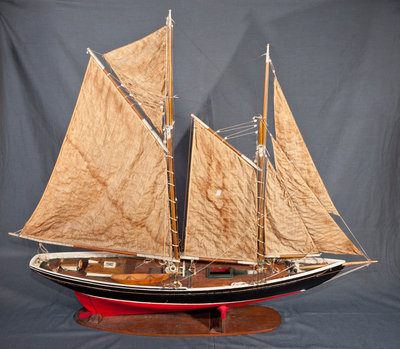
Bluenose I Details
This model is a replica of the “Bluenose I” schooner which was originally built in Nova Scotia in 1921. The model was made by Ken Shepherd who came from Nova Scotia to find work in Welland during the 1930’s. It is carved from a single block of wood. This model was purchased by H.H. Hilder, a furniture dealer from Welland. The Hilders would sail the model back and forth across the canal near the downtown Welland bridge. It was donated in memory of Edwin Hilder by Flavio Botari.

E.B. Audrey Hall Details
This is a large model of the laker the “E.B. Audrey Hall.” By 1918, 182 meter (600 foot) lakers were the largest ships on the Great Lakes and became the standard for all Great Lakes fleets for the next 35 years. The real “E.B. Audrey Hall” was owned and operated by Hall Transportation Corp on the Great Lakes. The model is nearly two meters in length and was donated by Peter Vargo.

Bluenose II Details
The original “Bluenose” was captained by Angus Walters and sailed in a series of schooner races, beating the “Elsie” in 1921, the “Henry Ford” in 1922 and the “Gertrude L. Thebuad” in 1923, all American vessels from the famous Glouster shipyards near Boston. Her final race in 1938 was another victory over the “Gertrude” but the “Bluenose” came to an ignoble end after being converted to a freighter and running aground off the coast of Haiti in 1946. The “Bluenose” was modelled after the Baltimore clippers, designed for both safety and speed, allowing their crews to bring in their catches early for the best price. The “Bluenose II,” is a reproduction of the original, and was christened in 1967 in honour of the Centennial celebrations. It is still moored in Halifax harbour today. This model is made of brightly painted wood, has a Canadian dime attached to its first mast, and all of the provincial and territorial flags flying off the second. It was made by the donor Ted Koszucki in 1990.
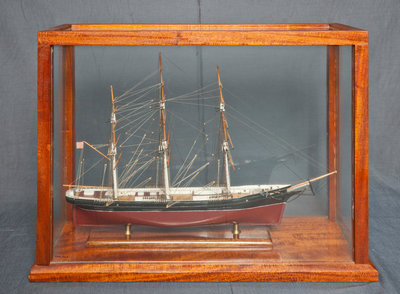
Clipper Ship Details
Clippers were fast sailing ships of the 19th century. They were generally quite narrow and built mostly in British and American shipyards. They weren’t well suited to carry large amounts of freight and were therefore primarily used for the transportation of low-volume, high-profit goods such as tea. This model of a Clipper was built by the donor Capt. J.W. Sharpe in 1945-1946 and is encased in a mahogany and glass case.
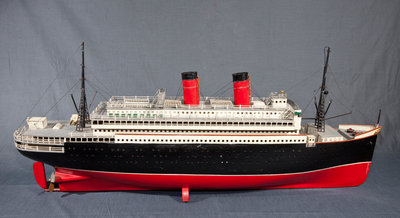
Cunard Line Details
This passenger ship model is made of metal and is patterned after ships that were constructed by Cunard Line in the first half of the 20th century. Mr. J.R. Sidey had it made 60-70 years ago for display in his store. Cunard Line is a British cruise line that was founded by Canadian born Samuel Cunard in 1840 and is still active today. The model was donated by Amey Sidey.
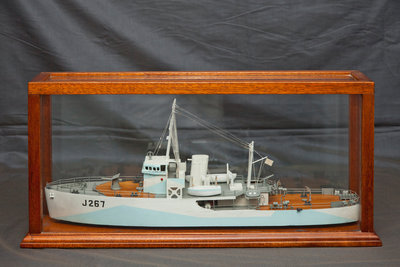
HMCS Digby Details
This is a model of the Bangor-class minesweeper “HMCS Digby – J267” that served from 1942-1945 during World War II. It was built in 1943 by the donor, Capt. J.W. Sharpe, who was also the Commanding Officer of “HMCS Digby.”
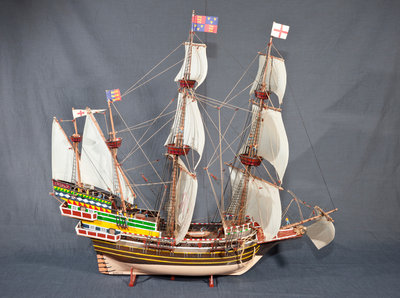
English Man O'War Details
This model is a representation of an English Man O’ War, a type of armed vessel that could carry up to 124 guns. It was first developed in England during the 17th century. The model was constructed in 1986 from a kit by Charles Conner, the brother of the donor Patricia Conner. The four flags are made of paper, the rigging is made of string, and the remainder of the ship is made of plastic. The small figures of the crew as well as the ship are both hand-painted.
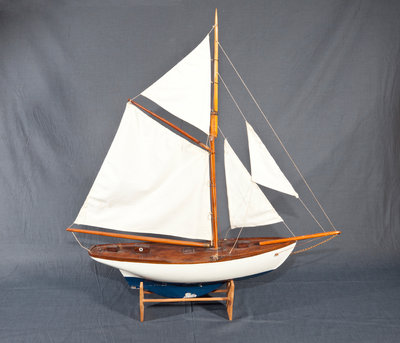
Fishing Sloop Details
Made in 1918 by a retired sailor at Sailors Snug Harbour, a home for retired sailors in Staten Island, N.Y., this model was donated by Mr. and Mrs. J. Walter. At the time of its donation it was the 23rd artifact to be donated to the Port Colborne Museum’s collection which now numbers over 16,000.
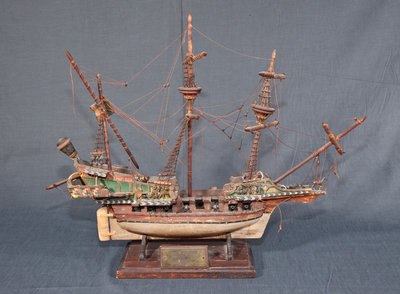
Golden Hind Details
The “Golden Hind” was sailed by Francis Drake during a voyage that lasted from 1577-1580 and would make him the first Englishman to circumnavigate the globe. She was originally named “Pelican” but Sir Francis Drake renamed her mid-voyage in 1577. After the completion of the voyage, Queen Elizabeth I knighted Drake on deck.
This ship model was built by Hugh Hasiltine during World War II while serving on a destroyer during one of the Murmansk Convoys to Russia. He gave it to the donor Marshall Henderson in Edinburgh around 1960. The brass plaque attached to the base reads “Golden Hind – 16th Century – Captain Sir Francis Drake.” The model and base are made of wood, and brown string was used for the rigging. The model is hand-painted, and the flag attached to the rigging at the stern is cardboard.

Gracie May Details
This is a handcrafted model of a fishing ship. Commercial fishing began in the 1880’s on the Great Lakes. Catches increased with the invention of more modern fishing equipment, but the golden days of commercial fishing were over by the late 1950’s. The model was donated from the estate of Louisa Gosse and was made by her brother-in-law Richard Gosse.

HMCS Haida Details
This is a 7-foot scale model of “HMCS Haida” a World War II and Korean War veteran destroyer called the “Fightingest Ship” in the Royal Canadian Navy. The Haida was commissioned in August of 1943 and was retired after 20 years of service. She is now permanently berthed at Ontario Place in Toronto.
The model was constructed with a scale of 1” = 4’, and was made by the donor Marcel Lanneval as a radio-controlled model. Marcel began his hobby in the 1970’s and continued until 1995. Marcel Lanneval was born and raised in Port Colborne and thus donated it to the Port Colborne Historical and Marine Museum.
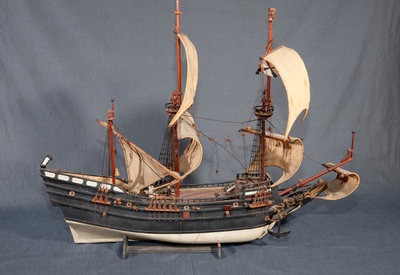
Halvemaen Details
The “Halvemaen” was a ship of the Dutch East India Company. It was commissioned by the Dutch Republic in order to find an eastern passage to China, and was captained by Henry Hudson. Two replicas of this ship have been built, the first in 1909 by the Kingdom of the Netherlands, and the second in 1989 in Albany, New York. Donated by Steven Young, this model was handcrafted out of wood c. 1900 and came from the home of the donor’s parents.
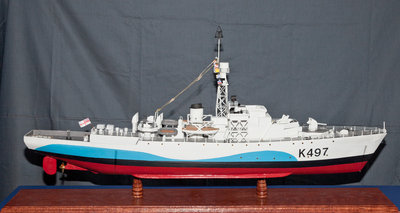
HMCS Humberstone Details
This model is a replica of “HMCS Humberstone,” a Castle Class Corvette that served from during World War II from 1944-1945. For most of the war she served as an ocean escort in the Atlantic. It was constructed for the Museum by Joseph Vella of the “West Island Ship Modellers Club.”
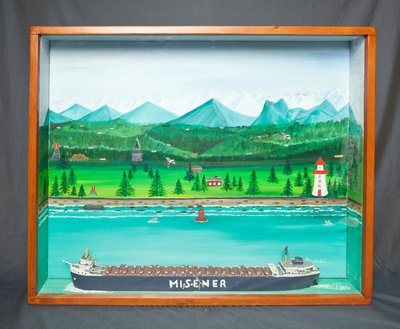
Misener Details
This is a large framed glass diorama of a Misener Ship Model. It was built in 1992 by the donor Gordon Conyou who worked for 22 years with Misener. The colourful, hand painted scene depicts a waterway in a mountainous rural area and a blue and white painted laker passing by. The ship was built in two pieces and fitted together. Misener ships have a long history of sailing along the Welland Canal. On October 16, 1954 the “Scott Misener” set a record when it topped the 800,000 bushel mark for the first time with a load of barley from Fort William to Port Colborne.
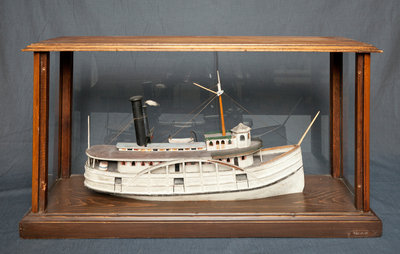
Northern Queen Details
This is a wood painted model of the ship the “Northern Queen” that was donated by Beryl Pickersgill. It came from Mrs. Pickersgill’s mother’s side of the family’s home in Goderich. Its restoration was completed on March 16, 1982.
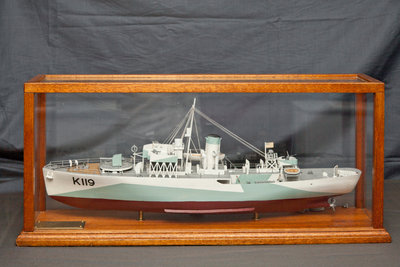
HMCS Orillia Details
This is a model of the Corvette “HMCS Orillia – K119” which served from 1940-1945 during World War II. It was built in 1944 by the donor, Capt. J.W. Sharpe, who was also the Commanding Officer of the “HMCS Orillia.” The brass plaque inside of the case reads “HMCS Orillia 1944, Lt. J. Sharpe, R.C.N.R. C.O.”
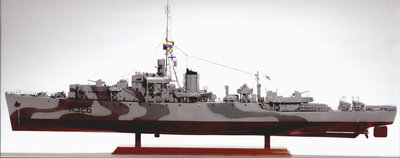
HMCS Port Colborne Details
This model is a replica of “HMCS Port Colborne,” a River Class Frigate that served from 1943-1945 during World War II. Some of its duties during the war included operating in the English Channel during the invasion of Normandy, serving off the coasts of France and Gibraltar, and escorting merchant ships during the Murmansk Convoys to Russia. Following the conclusion of the war she was broken up for scrap. The Museum possesses this model due to the contributions of a former crewmember Murray Sherwin, who organized the project and provided detailed plans for its construction. The model was built in nine months by seventeen members of the “West Island Ship Modellers Club” based out of Montreal.
HMCS Port Colborne and HMCS Humberstone are currently on exhibit at the Port Colborne Museum. “Firing a Royal Salute,” in honour of the 100th Anniversary of the Canadian Navy will be in place until mid-December, 2010.
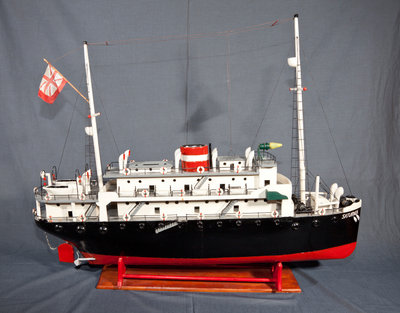
Saturnia Details
This model is a representation of the turn of the century Italian ocean liner the “Saturnia”. The hull, masts, lifeboats and cabin are constructed of wood with metal railings. The smoke funnel and vents located on the top deck, bow of ship and stern are made of plastic. The rigging attached to both of the masts is made of fine cord, and the flag is made from a satin material. The model was made c. 1990 by William Cramp, the Great-Great Uncle of the donor Steven Young.
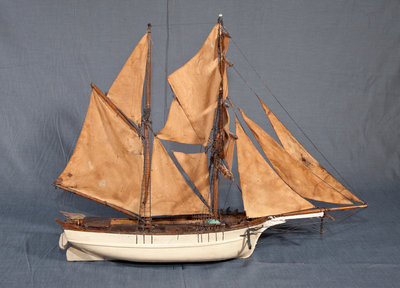
Seagull of Oakville Details
This model is a representation of a schooner that sailed on the Great Lakes. Schooners have been in use for centuries having being first developed by the Dutch in the 16th or 17th century, and then being further refined in North America since the early 18th century. The model is currently on loan from Capt. John Leonard of Port Dalhousie.
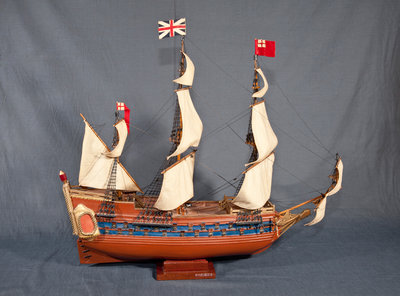
Sovereign of the Seas Details
The “Sovereign of the Seas” was a 90-gun First Rate ship of the line of the English Royal Navy. It was built by Charles I in 1635 in order to bolster the reputation of the English crown, and was completely destroyed in an accidental fire in 1697. This replica of “Sovereign of the Seas” was built by the donor Harry Nixey from a kit.
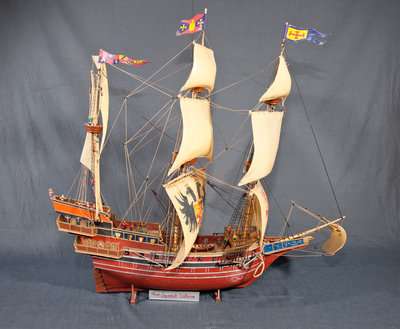
Spanish Galleon Details
This model is a representation of a 16th Century Spanish Galleon, a multi-decked sailing ship used for both war and trade. The model was constructed from a kit in 1986 by Charles Conner, the brother of the donor Patricia Conner. The three flags are made of paper, the rigging and anchor rope is made of string, and the remainder of the ship is made of plastic. The small figures of the crew as well as the ship are both hand-painted.
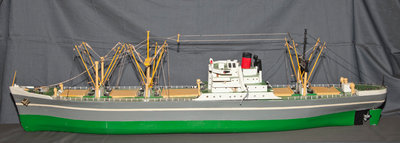
St. Helena Details
This is a model of the ship “St. Helena” that was built by the donor Robert Humpage in 1976. The model was once operated by remote control. The actual “St. Helena” sailed on the Welland Canal. The model is made of wood, while string is used for the ropes. The anchors, chains and rope-winder are metal, and the rope pulleys are plastic.
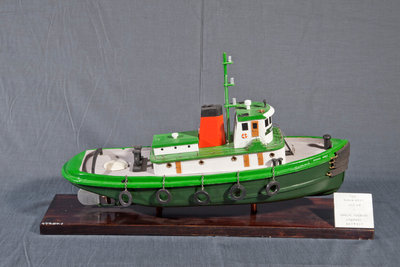
Susan Hoey Details
This model was purchased around 1980 by the donor Jim Gallant from a model builder in Goderich Ontario. The actual “Susan Hoey” was built at Grosse Ile, Michigan and was owned by the Gaelic Tugboat Company which had offices in the same area. The Hoey was built in 1952 and then rebuilt in 1985. Its engine is 750 horsepower. It was sold by the Gaelic Tugboat Company in 1997, and was renamed the “Robin Lynn”. It is still active on the Great Lakes today.
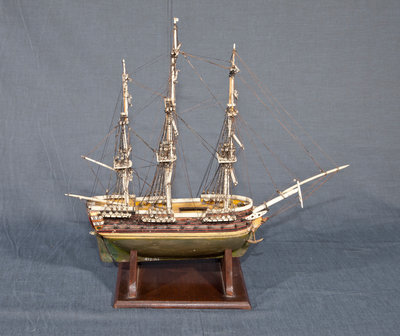
Bone Model Details
This model was donated by Miss Erie Carter. It had originally belonged to her father DeWitt Carter who bought it second hand and had it restored approximately 65-70 years ago. It is a model of a warship that was constructed of bone by a French prisoner-of-war during the Napoleonic Wars. Bone models were made in many different prisons during this period. Mutton bones that came from the prisoners’ meals’ were often used in the ships construction; however the bones of deceased prisoners called “Dieppe Ivory” were occasionally used as well. It has been suggested that the models were often the work of syndicates whose members collaborated, each prisoner contributing a particular skill to one feature of the model. They were made not only to while away the tedium of captivity but to make money with which food and comforts could be purchased. Different methods were used in the construction of the models. Sometimes the hull was shaped from a single bone, but more often the models were ribbed and planked like real vessels, with tiny nails inserted to hold the frame together. Human hair was often used for the rigging, as well as horsehair and silk. The scale of these models is not always accurate, as the modellers had to work by eye. The decoration of the ships is often excessive, but the result is a delightful work of art, achieved by craftsmen. In fact, bone models became so popular that they continued to be made after the end of the Napoleonic Wars in 1815. Models exist of ships which were not launched until 1820 or 1825.
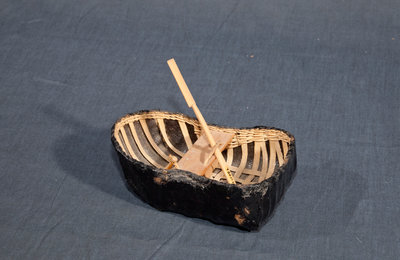
Welsh Fishing Boat Details
This is a model of a Welsh salmon fishing boat called a “coracle.” “Coracles” are designed to sail on fast flowing rivers and are usually made of a framework of split and interwoven willow rods tied with willow bark. They have been used for centuries being first noted by Julius Caesar in 55 BC during his invasions of Britain, and are still in use today. This model was donated by Noel Reakes.
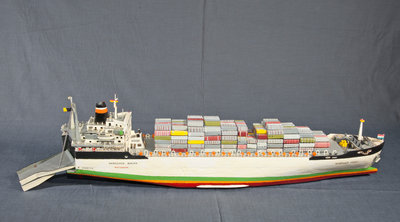
MS Nedlloyd Rouen Details
This is a model of the ship “MS Nedlloyd Rouen” that was made in 1990 by the donor Ted Koszucki. The “Nedlloyd Rouen” was a container ship based out of Rotterdam in the Netherlands. The deck of the model is covered with containers which would have been unloaded directly onto tractor-trailers. Real chains were used for the ramp as well as for the anchors, while the guardrails are made of string. The “Nedlloyd Rouen” had three decks, was 212 meters long, 32 meters wide, weighed 25,000 tonnes empty, and had a top speed of 19.5 knots. It was built by Nippon Kokan Co. in Japan for the Netherlands in 1978.

The "Mary" Details
This model originally belonged to the Merritt Family. Merritt was the family name of the donor’s mother. The Merritts were farmers at Attercliff, near Dunnville. The model was kept on the mantelpiece at the farm and was donated by Ross Bartlett.
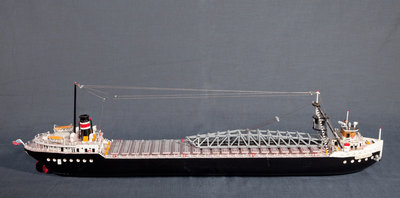
John A. Kling Details
The “John A. Kling” was a self-unloader which could carry most types of dry bulk cargo such as coal, gravel, etc. It was built in 1922 by the Manitowoc Shipbuilding Company of Wisconsin. The “Kling” was owned by Reiss Steamship Company, and was named for Mr. John Adam Kling, who consolidated four Cleveland building supply companies into a new company called Cleveland Builders Supply in 1897. He served the company first as a general manager, and then in 1900 as its elected president until his death in 1936. This model was built in 1990 by its donor Ted Koszucki.

Bottle Ships Details
The building of model ships is a rather old tradition that has been practiced for over 4000 years. However, the art of bottled ship making occurred much more recently due to the poor quality of early bottles. The first bottled ships began to be seen around the middle of the 19th century, and they have remained a popular pastime for sailors and hobbyists ever since.
The top two bottles are both representations of the famous Nova Scotia schooner the “Bluenose.” They were both made and donated by Parker M. Leney. The ship located in the bottom left is called the “Lizbeth” and was crafted by a German Merchant Seaman that was a prisoner of war at the Erie Peat Plant during the Second World War. It was donated by Mr. Stan Parker. The final is a bottle containing a warship and a black submarine that was made by a group of German Prisoners who were also interred at the Erie Peat Plant during the Second World War. The bottle was made for Ivan Staag, who delivered bread for Wrights Bakery to the camp. It was donated by Mrs. Theda Babion, Ivan’s sister.
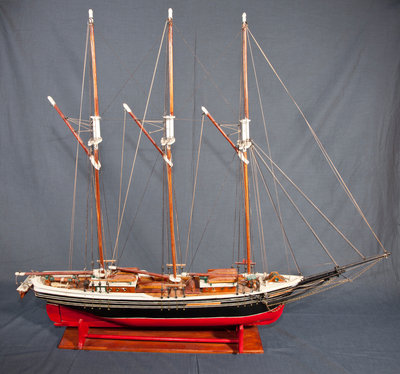
Gaspe Trader Details
This is a model of the wooden auxiliary schooner the “Gaspe Trader” which was originally built in 1918 by H.A. Ellis of Barachois, Quebec. Auxiliary sailing vessels are ships that are primarily powered by sail but also have engines that can be used when needed.
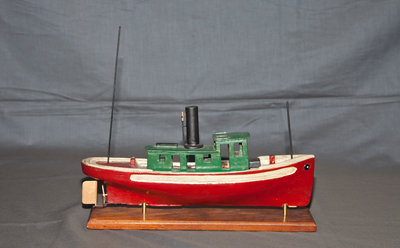
USA Tugboat Details
This is a model of a tugboat that was handcrafted c. 1890 by P.J. Carr. Tugboats such as this have been operating on waterways for nearly 200 years. They are often used to maneuver large vessels that cannot safely move themselves in crowded harbours or canals, or to move ships that lack their own propulsion system such as barges, disabled ships or oil platforms.
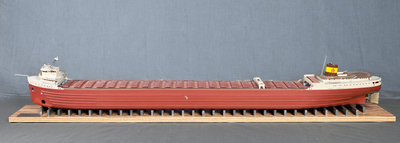
SS Edmund Fitzgerald Details
This ship is modelled after the Great Lakes freighter “The SS Edmund Fitzgerald”, which was built in 1957, and shipwrecked in a storm on Lake Superior on November 10, 1975. This shipwrecking is one of the most famous on the Great Lakes and was commemorated in Gordon Lightfoot’s 1976 song “The Wreck of the Edmund Fitzgerald”. The model was made in 1990 by the donor, Jack Kipfer, and is almost 4 feet in length.
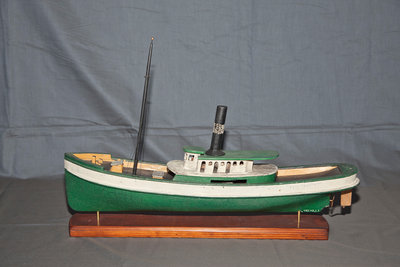
Propeller Ship Details
This is a model of a propeller powered ship that was handcrafted c. 1890 by P.J. Carr. With the start of widespread application of steam powered engines to ships in the early 19th century more ships began to move away from their traditional wind powered sails. Due to the poor design of early propellers, many ships initially used paddle wheels as their primary propulsion system. However, throughout the 19th century, the design of propellers gradually improved until they eventually became the dominant propulsion system that is still used today.
